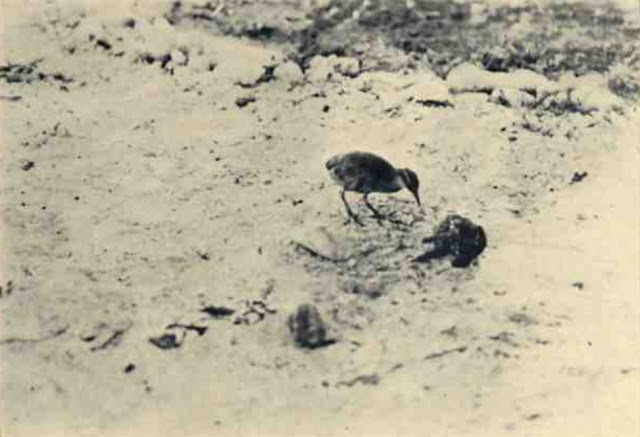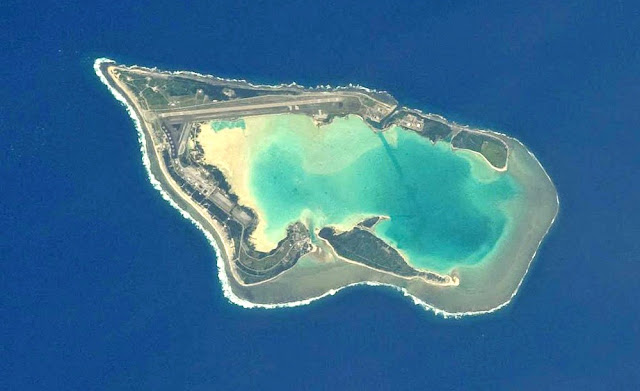
The day Japan bombed Pear Harbor, many American outposts in the Pacific, such as Philippines, Guam, Midway, Wake Island, Malaya, Thailand, and Shanghai also came under aerial attack. These raids took place within a few hours after the bombing of Pearl Harbor’s naval base had begun.
One of the targets, Wake Island, was a tiny atoll located strategically between two other American possessions, Guam and Midway islands. Message of the attack on Pearl Harbor was received by the garrison on Wake Island at 6:50 AM local time; but the date was December 8, 1941—a full 22 hours ahead of Pearl Harbor because Wake Island was situated on the other side of the international date line. Without wasting much time, Wake Island’s commander, Marine Corps Major James Devereux, ordered his men to prepare for combat, and four of the twelve Wildcat fighter aircraft on the island’s airbase were sent up to keep watch.
At noon, thirty six Mitsubishi G3M medium bombers flew in from Marshall Islands, 700 miles to the south, and caught the defenders by surprise. Rain obscured their approach, and even as the four Wildcats patrolled the skies, the bombers sneaked in and dropped their load all over the tiny island. The bombers did extensive damage, destroying the eight Wildcat fighters parked on the air field, while also igniting fuel dumps, leveling warehouses, and knocking off antennas. For the next two weeks, the Japanese plummeted Wake Island with bombs, eventually overpowering the Americans and establishing a Japanese garrison on the island.
Related: The 98 Rock of Wake Island
The Japanese maintained a stronghold on the island till the end of the war, but as the war progressed and the Allies’ domination over Japan increased elsewhere, the Americans pushed the Japanese contingent on Wake Island into a tight corner. Instead of attempting an invasion, the Americans simply cut the routes through which the Japanese received support and supplies. Facing starvation, the Japanese troops began to eat whatever they could hunt. Fortunately for them, Wake Island had a large population of seabirds.

Image credit: Smithsonian Institution Archives
Being the only island in hundreds of miles of open water (the nearest island is Utirik Atoll in the Marshall Islands, nearly 600 miles away), Wake Island was the perfect layover point for dozens of seabird species. In fact, birds were the only thing the island had. When Spanish explorer Álvaro de Mendaña de Neyra landed on the island in 1568 in search for fresh water, he found Wake Island to be waterless with not even a coconut tree. He remarked with distaste that “there was nothing on it but sea-birds, and sandy places covered with bushes.”
Before the war, Wake Island’s abundant bird population often attracted Japanese feather poachers who used to camp on the island and catch birds to harvest their feathers. Although a US territory since 1898, Wake Island was rarely visited by American ships allowing these illegal poachers to operate. Feathers and plumage were in great demand among European fashion houses and also for the manufacture of pillow and bedspread worldwide.
Most of the birds the poachers were after were migratory, such as albatross, frigatebird and terns. But one species lived there year-round. The Wake Island rail (Gallirallus wakensis) was a tiny, flightless bird about 22 centimeters in length. It had dark greyish brown plumage with striking narrow white bars on the belly, the breast, and the flanks. Without fresh water, the Wake Island rail was able to eke out a surprising sustenance on molluscs, insects, worms and seeds alone.
It was this bird that the Japanese preyed upon for food because they were easy to hunt. By 1945, every living rail had been killed and eaten out of existence.

Image credit: fieldguidetoextinctbirds.com
Related: How A Single Cat Hunted to Extinction The Entire Species of Stephens Island Wren
Six years later, when Dr. Alfred M. Bailey visited Wake Island for a scientific study, he found the island “nearly devoid of bird life, other than a few sea and migratory species.” Dr. Bailey noted that the “Wake rails had not been seen since the island was reoccupied by Americans.”
Ironically, the Japanese troops were specifically instructed by their commanders not to hunt the albatross fearing they will drive the bird to extinction. In his Notes on the birds of Midway and Wake Islands, Dr. Bailey quotes from the diary of a Japanese officer regarding daily bombing by American planes.
“An order has just come out," states the diary, “forbidding us to catch gooney birds (albatross), lest they be wiped out.”
Dr. Bailey continues: “The effort of this officer to protect the 'gooney birds must have been largely in vain. Most of the birds were destroyed by the starving soldiers, although a great colony of sooty terns (Sterna fuscata) was guarded so that the eggs could be gathered regularly.”
Nearly every bird species suffered from the Japanese occupation of Wake Island. Dr. Bailey noted that he saw no boobies, or red-tailed tropicbirds, or albatrosses either.
The Wake Island rail remains one of most poorly studied birds. Only a handful of scientific papers mention the species. The number of surviving specimens in museums is also low.

A rare photograph of a Wake Island rail from a 1936 book.
How War Drove to Extinction The Wake Island Rail
4/
5
Oleh
Chandu Numerology







